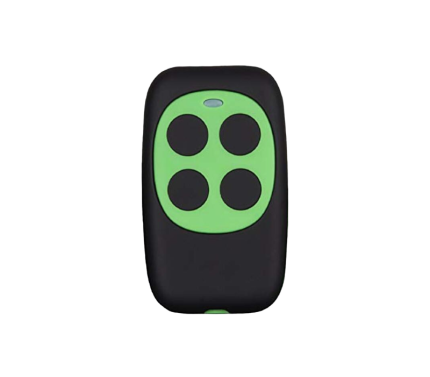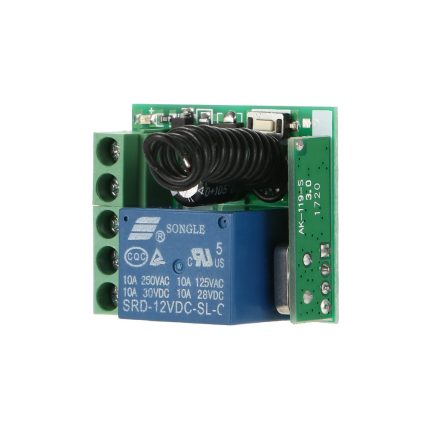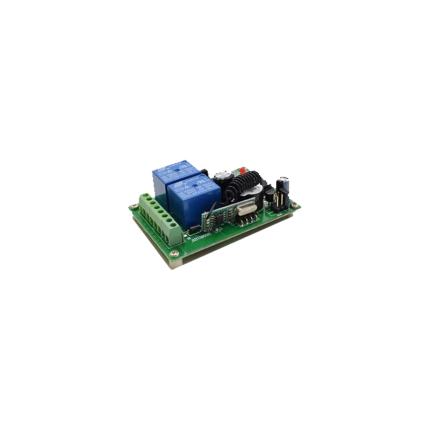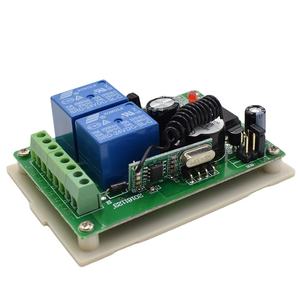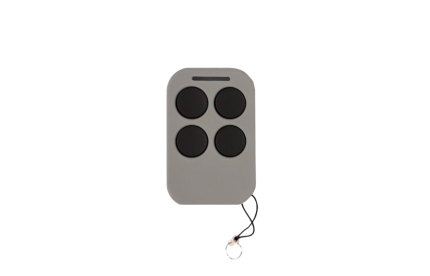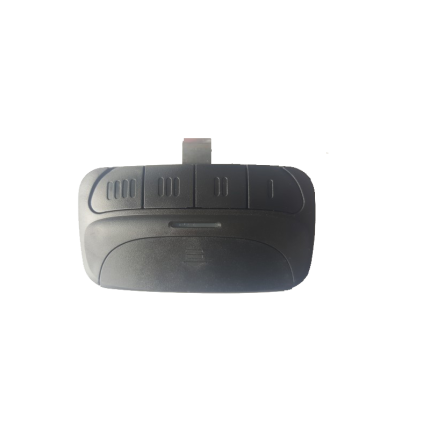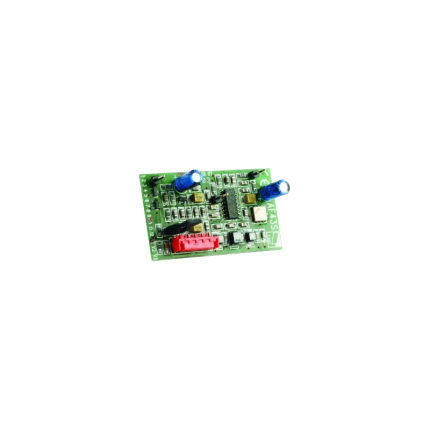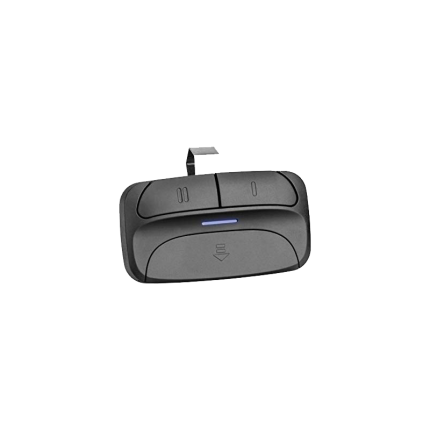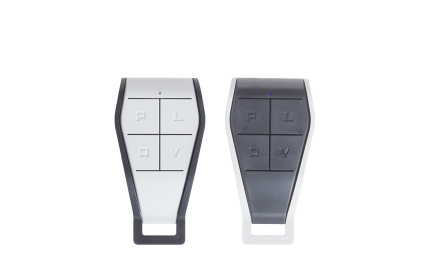remote
Gate Opener Remote Control
Ship or pick up from our office.
Gate Opener Remote Control
(More than 100 different designs) *433 MHz *2-5 Buttons A gate opener remote control is a handheld device that allows you to wirelessly open and close an automatic gate from a distance. It's a key component of an automated gate system, offering convenience and enhanced security for residential, commercial, and industrial properties. Here's a breakdown of what it is and how it works: What it is:- Handheld device: Typically small and portable, often designed to be kept in a car, on a keychain, or mounted on a visor.
- Transmitter: It contains a small radio transmitter that sends a wireless signal.
- User interface: Usually features one or more buttons to command the gate (e.g., open, close, stop).
- Signal Transmission: When you press a button on the remote, it sends a digitally encoded radio frequency (RF) signal (typically in the 300 to 900 MHz range) through the air.
- Signal Reception: A receiver unit, connected to the gate motor, is tuned to the same frequency as the remote. It picks up this signal.
- Signal Decoding: The receiver interprets the coded information embedded in the signal to understand the desired action (e.g., open the gate).
- Motor Activation: The decoded signal is sent to the gate's control board, which then activates the gate motor.
- Gate Movement: The motor, through various mechanisms (gears, chains, arms), physically moves the gate to open or close.
- Convenience: Allows you to operate the gate without leaving your vehicle, especially useful in bad weather or at night.
- Security: Provides controlled access to your property, deterring unauthorized entry. Many modern remotes use "rolling code" technology, which changes the code with each use, making it harder for unauthorized individuals to intercept and duplicate the signal.
- Range: Typically works within a certain distance, ranging from 20-50 feet up to 100 feet or more, depending on the model and environment.
- Compatibility: Most remotes are designed to work with specific gate opener brands and models, though universal remotes exist that can be programmed to work with various systems.
- Multiple Remotes: Many gate openers can be paired with multiple remotes, allowing several authorized users to control the gate.
- Integration: Some advanced systems can be integrated with smartphone apps, keypads, or other smart home devices for even greater control and monitoring.
- Safety Features: Often used in conjunction with safety sensors (like photo eyes or pressure sensors) that detect obstructions and prevent the gate from closing on people or objects.
Gate Opener Remote Control
Ship or pick up from our office.
Gate Opener Remote Control
– Copy Code typeGate opener remote controls use two main code types for copying: fixed code and rolling code.
Fixed code remotes are simpler and easier to clone, while rolling code remotes offer enhanced security and require more advanced techniques for copying.
Gate Opener Remote Control Fixed Code type:
- How it works: A fixed code remote transmits the same code every time it's pressed.
- Cloning: These are generally easier to clone using a universal remote duplicator.
- Security: Less secure than rolling code, as the code can be intercepted and copied.
- Example: Commonly found in older or simpler gate opener systems.
Radio receiver RG433-24V1C
Ship or pick up from our office.
Radio receiver RG433-24V1C
* DC 24 V * 1 Channel * 433 MHz The Radio receiver RG433-24V1C is an electronic device primarily used in automated gate systems. It receives radio signals from a remote control, enabling it to open and close an automatic gate. 🚧 Key Features and Specifications- Frequency: It operates at 433 MHz, a common frequency for remote control applications.
- Voltage: It requires a DC 24V power supply. The "1C" in its name likely refers to its single channel capability, meaning it controls one function (e.g., opening/closing a single gate).
- Function: Its core function is to receive signals, decode commands, and then control the connected gate opener.
- Type: These receivers can be either internal (built into the gate opener unit) or external. External receivers are often used for added functionality or as backup.
- Physical Characteristics: It's a compact device, typically weighing around 0.08 kg with dimensions of approximately 8 × 6 × 3 cm.
- Remote Access: Allowing users to open and close gates wirelessly using a remote control.
- Security: Providing convenient and secure access to properties.
In essence, the RG433-24V1C acts as the "ear" for your automated gate, listening for commands from your remote control to manage access.
Radio receiver RG315-12V1C
Ship or pick up from our office.
Radio receiver RG315-12V1C
* DC 12 V * 1 Channel * 315 MHz * Compatible with the Homelink system The RG315-12V1C is a radio receiver designed for automatic gate operators and garage doors. 🚧 It operates at a frequency of 315 MHz and is compatible with a wide range of gate operators, including Italian, Chinese, swing gate, sliding gate, and overhead garage door systems. Key Features- Operating Frequency: 315 MHz
- Voltage: 12V DC
- Compatibility: Works with various gate operators and garage doors.
- Capacity: Can store up to 100 remote controls.
- Signal Penetration: Its wireless RF signals can effectively pass through walls, floors, doors, and windows.
- Design: It's compact, lightweight, portable, and easy to install.
- Multiple Units: Multiple RG315-12V1C units can be used in the same location without interference.
- Gate Openers: Allowing remote control of swing gates and sliding gates.
- Garage Door Openers: Enabling wireless operation of overhead garage doors.
Radio receiver RG315-12V2C
Ship or pick up from our office.
Radio receiver RG315-12V2C
*DC 12 V *2-CH *315 MHz * Compatible with Homelink systemRadio receiver RG315-24V2C
Ship or pick up from our office.
Radio receiver RG315-24V2C
*DC 24 V *2 Channels *315 MHz * Compatible with Homelink systemsGate Opener Remote Control -C4
Ship or pick up from our office.
Gate Opener Remote Control -C4
*433 MHz
*2-4 Buttons
*More than 10 different designs
Key features and functions of a gate opener remote control:
-
Remote Operation:Enables opening and closing the gate from a distance, typically within a certain range (e.g., 100 feet).
-
Radio Signal Transmission:Emits a radio signal to the gate's receiver unit, initiating the gate's movement.
-
Compatibility:Most remotes are compatible with specific gate openers and require the same frequency to function.
-
Programming:Can be programmed with the gate's receiver unit, often involving a "learn" or "program" button on the gate opener.
-
Multiple Remotes:Many gate openers can be paired with multiple remotes, allowing multiple users to control the gate.
-
Universal Remotes:Some universal remotes can be programmed to work with different gate opener brands, as long as they are compatible.
-
Safety Features:Some gate openers incorporate safety features like sensors that detect obstructions and reverse the gate's movement.
Gate Opener Remote Control
Ship or pick up from our office.
Gate Opener Remote Control
*With Visor Clip *433 MHz *4 ButtonsGate Opener Remote Control 1400FT315
Ship or pick up from our office.
Gate Opener Remote Control 1400FT315
*High-Range 1400ft *315 MHz *Compatible with HomeLink system on vehicles *1 channelDelay relay 0.5 Sec – AC 24 V to AC 24 V
Ship or pick up from our office.
Delay relay 0.5 Sec - AC 24 V to AC 24 V
delay relay 0.5 Sec - AC 24 V to AC 24 V is a type of electrical relay that introduces a 0.5-second time delay in a circuit, specifically designed to operate with a 24-volt AC (Alternating Current) power supply. This means that when the control voltage (24V AC) is applied or removed, the relay's output contacts won't change their state immediately; instead, there will be a half-second pause before they do. Here's a breakdown of what each part of the description means:- Delay Relay (or Time Delay Relay/Timer Relay): This is a control device that, unlike a standard relay, incorporates a timing function. It's used to control an event based on a pre-selected time interval.
- 0.5 Sec: This specifies the duration of the time delay. In this case, it's a very short half-second delay. Time delays can range from milliseconds to hours or even days, depending on the relay.
- AC 24 V (Input/Control Voltage): This indicates the type and voltage of the power supply required to energize the relay's coil or internal control circuitry. "AC" means Alternating Current, and "24 V" is the nominal voltage.
- to AC 24 V (Output/Load Voltage): While not explicitly stated as "output," this implies that the relay is likely intended to switch a 24V AC load. This means the contacts within the relay are rated to handle 24V AC to control another part of the circuit or a device. It's important to note that the load voltage can sometimes be different from the control voltage, but in this specific phrasing, it suggests both are 24V AC.
- On-Delay (Normally-Open, Timed-Closed - NOTC): The most common type. When the control voltage is applied, the timing period begins. After 0.5 seconds, the output contacts close. The contacts remain closed as long as the control voltage is present.
- Off-Delay (Normally-Open, Timed-Open - NOTO): When the control voltage is applied, the output contacts close immediately. When the control voltage is removed, the 0.5-second delay begins. After this delay, the contacts open.
- One-Shot: Provides a single output pulse of a specified duration (in this case, 0.5 seconds) when triggered.
- Repeat Cycle: Alternates between ON and OFF states for defined durations, creating a repeating cycle. This particular relay with a fixed 0.5-second delay is less likely to be a multi-function repeat cycle unless it's just one setting within a programmable unit.
- Sequencing Operations: Ensuring one component starts or stops slightly after another in a controlled sequence.
- Motor Control: Providing a brief delay before starting a motor (e.g., for pre-lubrication pumps to stabilize).
- Safety Interlocks: Implementing a short delay to ensure certain conditions are met before an action can occur.
- HVAC Systems: Timing the activation or deactivation of fans, compressors, or other components.
- Conveyor Systems: Coordinating the starting or stopping of multiple conveyor belts to prevent material jams.
- Lighting Control: For example, a short delay before turning on a light in a specific area
Garage Door Opener Remote Control
Ship or pick up from our office.
Garage Door Opener Remote Control
A garage door opener remote control is a small, handheld device that uses radio frequency (RF) signals to wirelessly communicate with your garage door opener system. Essentially, it's a transmitter that sends a unique code to a receiver built into your garage door motor unit, telling it to open or close the garage door. Here's a breakdown of how it works and its key features: Functionality:- Signal Transmission: When you press a button on the remote, it sends a radio frequency signal containing a specific code.
- Signal Reception: The garage door opener has a receiver that constantly "listens" for these signals.
- Code Matching: If the received code matches the opener's stored code, the receiver activates the motor.
- Motor Activation: The motor then powers a drive mechanism (chain, belt, screw, or direct drive) that moves the garage door up or down.
- Radio Frequency (RF) Communication: Most remotes operate using RF signals (commonly 315 MHz or 390 MHz), allowing them to work from a distance and even through walls.
- Fixed Code Technology (Older): Early remotes used a fixed code that was sent every time. This was less secure as the signal could be easily intercepted and duplicated.
- Rolling Code Technology (Modern): To improve security, modern remotes use rolling code technology. The code changes every time you press the button, making it extremely difficult for unauthorized individuals to "grab" and reuse the code. Brands like LiftMaster (Security+ / Security+ 2.0) and Genie (Intellicode®) use their own versions of this.
- Dip Switches (Older): Some older remotes used physical dip switches that needed to be manually set to match the receiver's code.
- Wi-Fi and Smart Home Integration: Many newer garage door openers feature built-in Wi-Fi, allowing you to control your garage door from anywhere using a smartphone app (e.g., MyQ for LiftMaster/Chamberlain, Aladdin Connect for Genie). These apps often offer additional features like real-time notifications, scheduling, and access history.
- Multi-Button Remotes: Some remotes have multiple buttons, allowing you to control several garage doors or even other devices like lights.
- Universal Remotes: These are programmable remotes designed to be compatible with various brands and models of garage door openers, reducing the need for multiple remotes.
- Standard Remotes: Basic remotes with one or more buttons to operate the garage door.
- Visor Remotes: Larger remotes designed to clip onto your car's sun visor for easy access while driving.
- Keychain Remotes: Small, compact remotes that can be attached to your keyring for portability.
- Keypad Remotes: Mounted outside your garage door, these allow you to enter a numerical code to open the door, useful for keyless entry.
Original Gate Opener Remote Control
Ship or pick up from our office.
Original Gate Opener Remote Control
*433 MHz *2-4 Buttons *(More than 10 different designs)A gate opener remote is a handheld device that allows you to remotely open and close an automatic gate.
It sends a radio signal to a receiver connected to the gate's motor, triggering the gate to move. These remotes are a convenient way to control access to properties, especially when entering or exiting with a vehicle.
Here's a more detailed explanation:
-
Function:The remote transmits a radio signal to a receiver unit connected to the gate opener motor.
-
Convenience:They eliminate the need to manually open or close the gate, providing convenience and security.
-
Compatibility:Remotes must be compatible with the gate opener's frequency and coding system.
-
Types:There are various types of remotes, including single-button (for basic open/close) and multi-button (for more complex functions like stopping or partially opening the gate).
-
Programming:Remotes need to be programmed to work with the specific gate opener.
-
Frequency:Most gate openers use 433.92 MHz frequency, but some older systems might use different frequencies.
-
Range:The range of the remote can vary depending on obstructions like trees or buildings.



